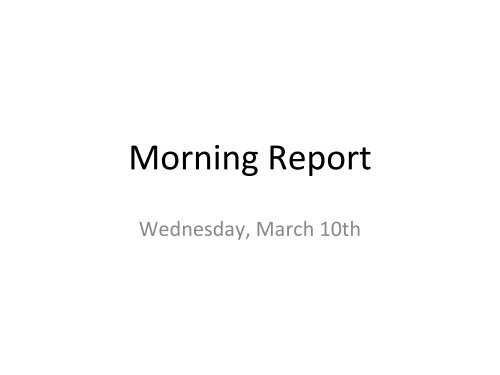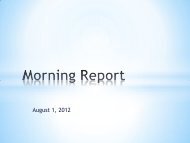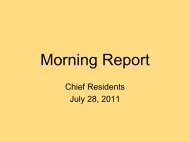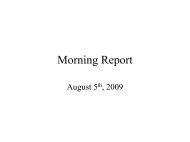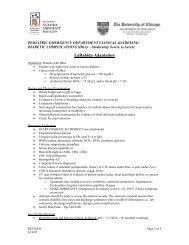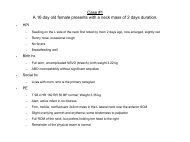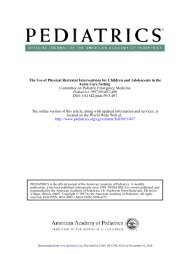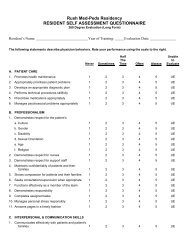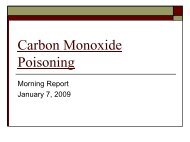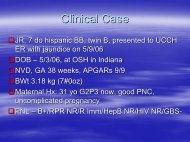Cyclic neutropenia
Cyclic neutropenia
Cyclic neutropenia
You also want an ePaper? Increase the reach of your titles
YUMPU automatically turns print PDFs into web optimized ePapers that Google loves.
Morning Report<br />
Wednesday, March 10th
You are following up labs at clinic…<br />
WBC: 8.2<br />
Diff: 3% Neutrophils, 71% lymphocytes, 17%<br />
monocytes, 8% eosinophils<br />
Hgb: 12.3<br />
Plts: 450<br />
Anything worrisome???
• What are the key questions on history?<br />
• What physical exam finding may help you with<br />
the diagnosis?
Physical Exam
Differential Diagnosis<br />
• Extrinsic to Marrow<br />
• Acquired Disorder of Marrow<br />
• Intrinsic to Marrow
Antineutrophil Antibodies
What’s Wrong With This<br />
Picture???<br />
Normal
What’s Wrong With This<br />
Picture???<br />
No Mature Neutrophils<br />
Dx: Immune Neutropenia
What’s Wrong With This<br />
Picture???<br />
No Bands or Mature Neutrophils. Mainly Immature<br />
Dx: Severe Congenital Neutropenia
Severe Congenital Neutropenia<br />
• ANC
Back to Our Patient<br />
• Recurring Oral Ulcers; sometimes w/fever<br />
• Father with hx “blood problem”<br />
• No hx hospitalizations or severe infx<br />
• Growing Appropriately<br />
• Physical Exam normal except oral lesions<br />
• Labs confirmed diagnosis
<strong>Cyclic</strong> Neutropenia<br />
• Autosomal Dominant; mutation ELA‐2 (diff location<br />
than Kostmann)<br />
• 21 +/‐ 5 day cycle with <strong>neutropenia</strong> 3‐6 days<br />
• May be symptomatic at nadir<br />
– Usually fever, oral ulcers, gingivitis, pharyngitis, skin<br />
– PNA, NEC, peritonitis, E. Coli or Clostridium sepsis<br />
• Confirm diagnosis by checking ANC 2‐3x weekly for 4‐6<br />
weeks to establish pattern<br />
• Treatment Dependent on Severity
Take Home Points<br />
• ANC varies with age and race<br />
• History and Physical provide key info to narrow DDx<br />
<strong>neutropenia</strong><br />
• Viral suppression top cause of <strong>neutropenia</strong><br />
• Management of cyclic <strong>neutropenia</strong> determined by<br />
presentation and ANC ‐ ‐ good dental hygiene,<br />
antibiotics & immediate eval for fever, consider G‐<br />
CSF
Goals & Objectives<br />
• Review key points history and physical in evaluation<br />
<strong>neutropenia</strong><br />
• Outline variations in ANC w/age & race<br />
• Discuss diagnostic approach for evaluation of <strong>neutropenia</strong><br />
• Construct DDx <strong>neutropenia</strong><br />
• Review management of neutropenic patients
Review Questions<br />
A 6 y/o boy presents with a hx of temp to 103 (39.4) and<br />
ulcerations on his lips and buccal mucosa 2 days ago. The child<br />
has some small, slightly ulcerated areas on his lips and is<br />
afebrile. Mom reports two simlar episodes in the past 2 months.<br />
He has a WBC count of 2.9; Hgb 11.4; Plt 349. Diff is 40%<br />
neutrophils, 49% lymphocytes, 9% monocytes and 2%<br />
eosinophils. Of the following, the best laboratory test to evaluate<br />
this child is:<br />
A. Antineutrophil Antibodies<br />
B. Blood Counts 2‐3x a week for 4‐6 wks<br />
C. Bone Marrow aspiration<br />
D. Herpes Cultures<br />
E. Repeat of the count in 1 week to see if it normalizes
Review Questions<br />
What is the most common underlying cause for mild to<br />
moderate <strong>neutropenia</strong>?<br />
A. Exposure to medications such as antibiotics<br />
B. Immune Neutropenia<br />
C. Schwachman‐Diamond Syndrome<br />
D. Sequestration<br />
E. Transient Marrow Suppression due to viral<br />
infection
Review Questions<br />
A previously well 3 y/o boy presents with 4 days of temp to 104<br />
(40). He is no acute distress and does not appear ill. The only<br />
abnormal physical finding is mild rhinitis. A complete blood<br />
count reveals WBC 1.5; Hgb 12.8, Plt 349. His differential count<br />
is 2% neutrophils, 80% lymphocytes, 10% monocytes, and 6%<br />
eosinophils. A blood culture is obtained. After a single dose of<br />
acetaminophen, the child becomes afebrile. Of the following, the<br />
most appropriate next step is to:<br />
A. Give a dose of broad spectrum antibiotics and admit for continuing<br />
IV antibiotics<br />
B. Give a dose of CTX and see the child the following morning<br />
C. Observe the child in the ER overnight<br />
D. See the child the following morning but tell the parents to call<br />
sooner if he becomes more ill<br />
E. Start amoxicillin and clavulanic acid orally and see the child the<br />
following morning
Review Questions<br />
At what age does alloimmune <strong>neutropenia</strong><br />
usually resolve?<br />
A. 2‐3 days<br />
B. 2‐3 weeks<br />
C. 5‐6 weeks<br />
D. 2‐3 months<br />
E. 6‐7 months


